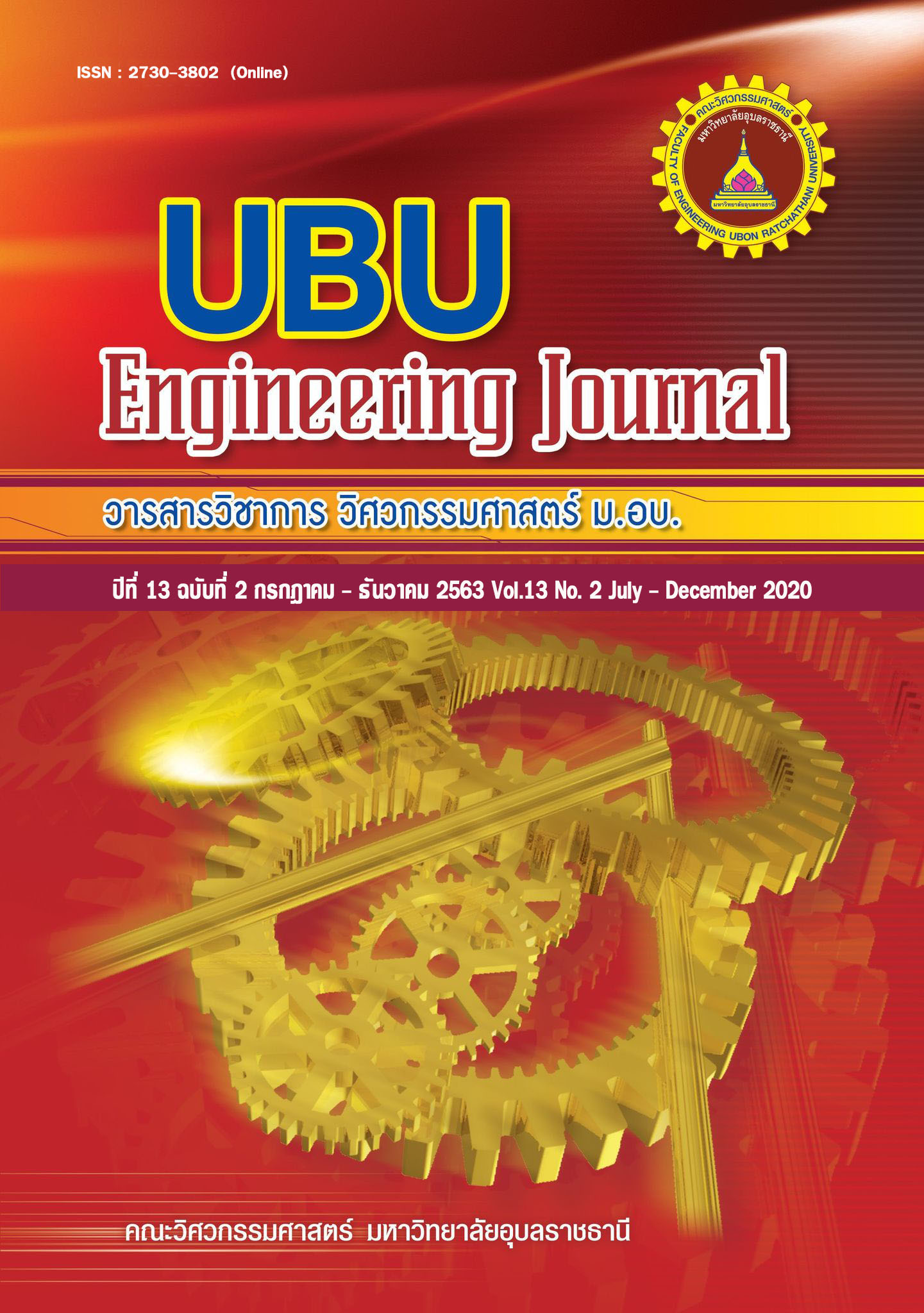Combined effect of pre-chlorination and coagulant addition on turbidity removal of the clarification water in water treatment plant by sludge blanket clarifier
Main Article Content
Abstract
This paper aims to study performance of turbidity removal of the clarification water in water treatment plant by sludge blanket clarifier. By controlling coagulant dosing rate, the results between pre-chlorination and no pre-chlorination addition on turbidity removal efficiency of the clarifier were compared. Experimental results found that the pre-chlorination addition was significantly affected on turbidity removal efficiency for the clarification water. The pre-chlorination addition provided higher turbidity removal efficiency than the no pre-chlorination addition. For, the pre-chlorination addition, turbidity removal efficiency was 86.3% ±1.7%. For the no pre-chlorination addition turbidity removal efficiency was 81.5% ±2.8%. Because of the pre-chlorination addition showed higher a decreased pH than the no pre-chlorination addition. The increasing in residual chlorine from the clarified water enhanced increasing of turbidity removal efficiency in polynomial relation. At a 18-mg/l alum dosage, the optimum residual chlorine from the clarified water was in range 0.12-0.16 mg/l which provided highest turbidity removal efficiency. The optimum residual chlorine enhanced turbidity removal efficiency about 2.7% ±1%.
Article Details
References
[2] Dorea CC. Coagulant-based emergency water treatment. Desalination.2009;248:83-90.
[3] American Water Works Association (AWWA), American Society of Civil Engineer (ASCE). Water treatment plant design. 4th ed. New York: McGRAW-Hill; 2005.
[4] Twort AC, Ratnayaka DD, Brandt MJ. Water supply. 5th ed. Oxford; Butterworth-Heinemann; 2011.
[5] World Health Organization (WHO). Guidelines for drinking-water quality. 4th ed. Geneva: WHO press; 2011.
[6] United States Environmental Protection Agency (USEPA). Drinking water treatment plant residuals management technical report. 2011. EPA 820-R-11-003.
[7] Sharp EL, Parsons SA, Jefferson B. Seasonal variations in natural organic matter and its impact on coagulation in water treatment. Science of the Total Environment. 2006;363:183-94.
[8] Mo W, Wang H, Jacob JM. Understanding the influence of climate change on the embodied energy of water supply. Water Research. 2016; 95:220-9.
[9] Degramont. Water treatmemt handbook. Vol.2. 6th ed. Paris: Lovoisier Publishing; 1991.
[10] Niu ZG, Hu XP, Zhang Y, Sun YY. Effect of chlorine dosage in prechlorination on trihalomethanes and haloacetics acids during water treatment process. Environmental Science and Pollution Research. 2016:1-10
[11] Phalakornkule C, Mangmeemak J, Intrachod K, Nantakumjorn P. Pretreatment of palm oil mill effluent by electrocoagulation. Scienceasia 2010;36:142-9.
[12] Lapsongpon T, Leungprasert S, Yoshimura C. Pre-chlorination contact time and the removal and control of Microcystis aeroginosa in coagulation. 7th International Conference on Environmental and Industrial Innovation, Earth and Environmental Science 2017;67:1-7.
[13] Ghenout D, Moulay S, Messaoudene NA, Aichouni M, Naceur MW, Boucherit A. Coagulation and chlorination of NOM and algae in water treatment: A review. International Journal of Environmental Monitoring and Analysis. 2014;2(6-1):23-34.
[14] Musikavong C, Inthanuchit K, Srimuang K Suksaroj TT, Suksaroj C. Reduction of fractionated dissolved organic matter and their trihalomethanes formation potential with enhanced coagulation. ScienceAsia. 2013;39:56-66.
[15] Ersoy B, Tosun I, Gunay A, Dikman S. Turbidity removal wastewaters of natural stone processing by flocculation/sedimentation methods. Clean. 2009;37(3):225-32.
[16] Ghadimkani AA, Torabian A, Mehrabadi AR. Preozonation and prechlorination effect on TOC removal in surface water treatment. Pakistan Journal of Biological Sciences. 2006;9(4):708-12.
[17] Torabian A, Ghadimkani AA, Mehrabadi AR, Shokouhi M, Heidarzadah R. Effect of preozonation and prechlorination on total organic carbon removal in surface water treatment in Iran. WIT Transactions on Ecology and the Environmental. 2007;103:305-14.

